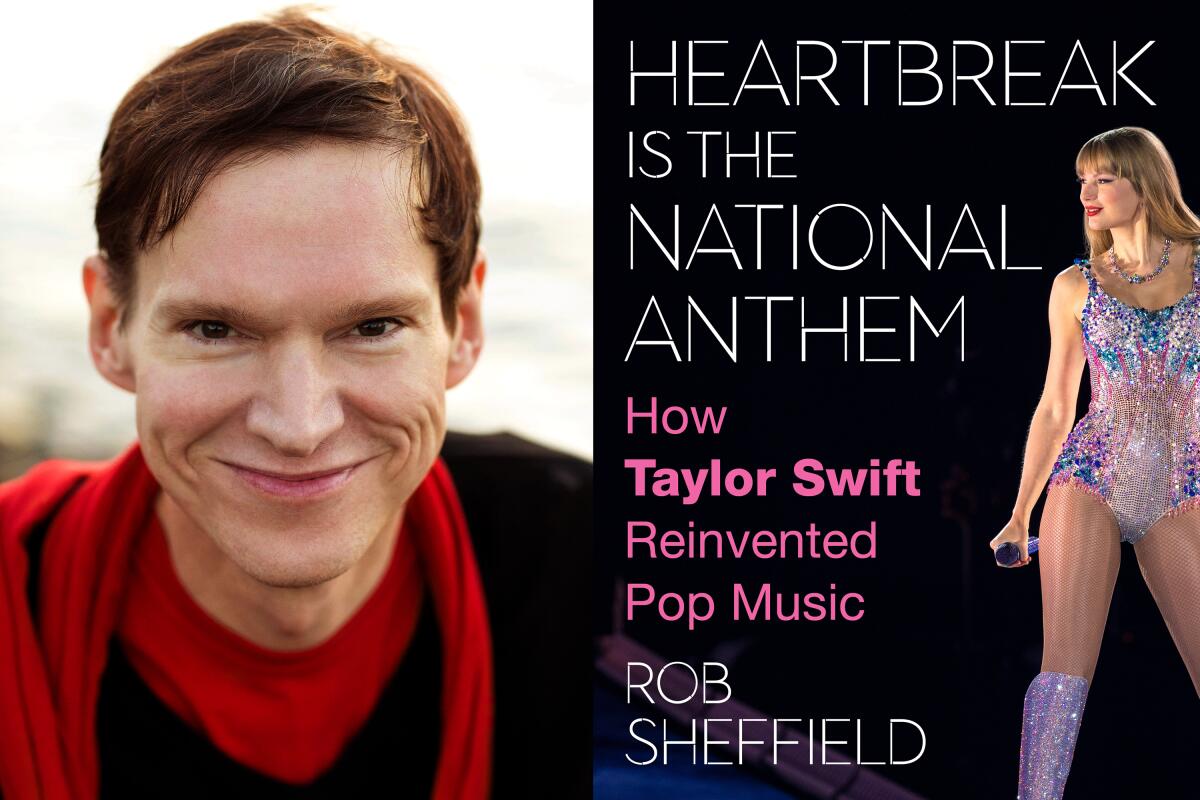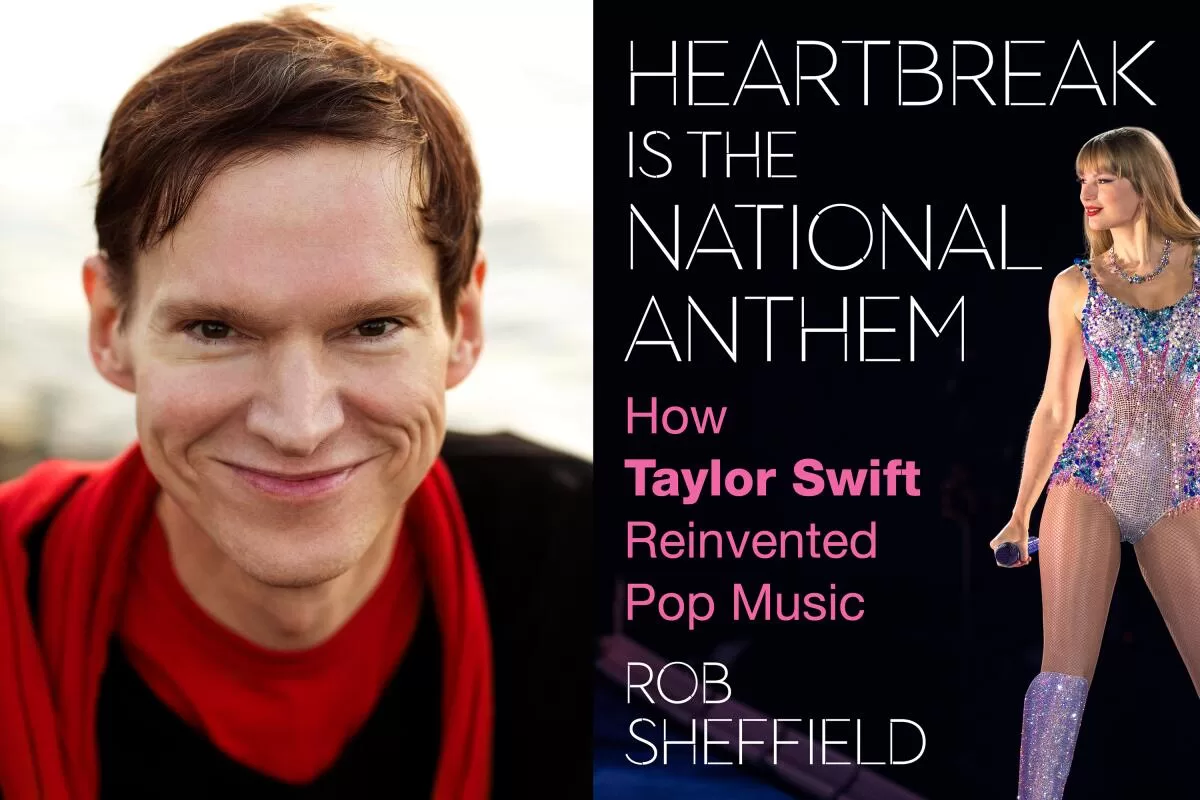Welcome to the L.A. Times Book Club newsletter.
Hello, fellow readers. I’m culture critic and fervent bookworm Chris Vognar. This week we speak with Rolling Stone pop music critic Rob Sheffield about his new book “Heartbreak Is the National Anthem: How Taylor Swift Reinvented Pop Music.” We also look at recent releases reviewed by Times critics. And following yesterday’s 2025 Grammys nominations — props to Beyoncé for becoming the most nominated artist in history — we recommend some great music books from years past.
The first time Rob Sheffield heard Taylor Swift he was making a grilled cheese sandwich and watching reruns of “Clueless” on the CW, which played pop songs in between episodes. On that day, one of those songs was “Our Song.” It knocked him sideways. “I loved every detail,” he writes in “Heartbreak.” “The banjo, the fiddle, her twang when she sings, ‘It’s late and your mama don’t know!’ But especially that ending, when the girl picks up her guitar and writes her favorite song, i.e., the one she just sang — the music she’s been waiting her whole life to hear.”
That was 2007. In the years since, Swift has become a pop colossus, a one-woman, billion-dollar industry whose songs speak to women (and more than a few men) around the world. In his new book, Sheffield, an avowed Swiftie whose previous works cover subjects including the Beatles and David Bowie, provides a passionate look at the artist and the phenomenon.
I spoke with him about Swift’s singularity, how she manages to provoke so many arguments and how pop music became one nation under Taylor.

Author Rob Sheffield with the jacket cover of his new book, “Heartbreak Is the National Anthem: How Taylor Swift Reinvented Pop Music.”
(Marisa Bettencourt; Day Street Books)
In the book’s subtitle, you argue that Taylor Swift reinvented pop music. Please explain.
She really transformed it in terms of centering it around the fangirl as the mover of pop music. When she arrived, the idea of a teenage girl with a guitar writing her own songs was almost like a novelty, almost like a racket. She was pretty much out on a limb. There weren’t many country [artists] who wrote their own songs in those days, even the ones who were great songwriters.
But now that’s just what pop music is. You’ve got Chappell Roan and Sabrina Carpenter and Billie Eilish and Olivia Rodrigo, all these young women who are working in a very individual style. They don’t sound like each other, and they don’t sound like Taylor Swift, but they’re all working in territory that she opened up.
You write, “She will jump into every feeling with the certainty that it’s the last one she’ll ever have.”
Yeah, she really makes a mess. She does not stick to a topic. She does not stick to a script. There are so many songs where there’ll be a love story, and then the couple starts to have one fight, and then another topic completely comes up. She’s absolutely happy to change the topic, midsong. Bob Dylan consciously likes to be an argument starter in much the way that Taylor does. I thought being a teenage Bob Dylan fan was the most exhausting fan experience I would ever have. But Taylor Swift is very much in that mode. She will change her mind about everything, about the song as she sings it from the beginning to the end.
And yet she also remains tenaciously career-focused, an industry unto herself.
It’s incredible that she writes these songs where emotionally, she’s really reckless. She’s veering from side to side. She’ll have 12 different moods in one song. And that goes side by side with an extremely focused, extremely driven approach to her career, where she has this obsessive need to keep trying to top herself and do something different next time. She never has a year where she’s doing a new and improved version of what she did last year. And that would honestly be more than good enough.
(Please note: The Times may earn a commission through links to Bookshop.org, whose fees support independent bookstores.)
Newsletter
You’re reading Book Club
An exclusive look at what we’re reading, book club events and our latest author interviews.
You may occasionally receive promotional content from the Los Angeles Times.
The week(s) in books

A long-awaited biography of Johnny Carson proves he’s the Everest of celebrity subjects — tempting but perilous, writes Mary McNamara.
(Photos by Ron Tom/NBC, Alice S. Hall/NBCU, Gene Arias/NBCU via Getty Images)
Abdi Nazemian reviews “Something Close to Nothing,” Tom Pyun’s new novel about a gay couple’s messy surrogacy journey. Nazemian writes that it’s “a restless novel about restless people whose American dreams are rarely satisfied.”
Marc Weingarten reviews Oliver Sacks’ “Letters,” a collection of correspondences from the late neurologist of many intellectual passions. Sacks, Weingarten writes, “was insatiably curious and wrote ceaselessly and joyfully about anything that caught his interest, which was just about everything.”
Roxsy Lin speaks with Luis Jaramillo about his new coming-of-age novel “The Witches of El Paso.” As Lin writes, the author “incorporated magical elements in his writing by presenting alternative realities for the main characters.”
And Mary McNamara reviews “Carson the Magnificent,” the new Johnny Carson biography completed by Mike Thomas after the original author, Bill Zehme, passed away. As McNamara writes, “Television continues to produce stars worthy of benedictions and analysis, but it’s difficult to imagine that any will leave as deep an imprint on his or her fans as Carson did.”
Further music reading

Fans enjoy Taylor Swift’s performance during a stop on The Eras Tour in California.
(Allen J. Schaben / Los Angeles Times)
Here is a (highly subjective and personal) collection of further music reading to consider once you’re done getting Swift with it.
“Can’t Stop Won’t Stop” by Jeff Chang: Chang’s chronicle of early hip-hop culture deftly places the music in historical and political context.
“A Visit From the Goon Squad” by Jennifer Egan: Egan’s deliriously entertaining Pulitzer-winning novel weaves together 13 tales of rock ‘n’ roll scenesters over a 40-year period.
“Three Shades of Blue” by James Kaplan: A group portrait of Miles Davis, John Coltrane and Bill Evans that conjures the revolutionary if fleeting universe of ‘50s jazz.
“33 Revolutions per Minute” by Dorian Lynskey: A history of the protest song, from Billie Holiday to Green Day, that should come in mighty handy right about now.
“Quantum Criminals” by Alex Pappademas and Joan LeMay: Pappademas provides the words, LeMay the illustrations in this barbed tour of the ramblers and wild gamblers who inhabit Steely Dan’s catalogue.
“The Rest Is Noise” by Alex Ross: A lively and engaging narrative of 20th century classical music from the New Yorker music critic.
That’s all for now. Don’t forget to keep on rockin’ in the free world.
